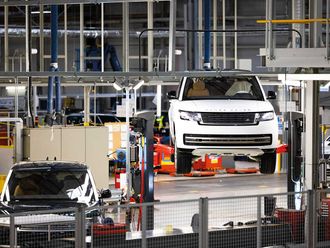Santa Monica: Frank Thode bought his first refrigerator from Sears in Santa Monica as a young newlywed. That was back in 1957. For nearly five decades, he stopped at the department store almost once a week, picking up tools or clothes or appliances. But in recent years, he has hardly ever gone by the distinctive green-and-white Modern-style store on Colorado Avenue near the Santa Monica Pier still bearing its original Sears neon sign.
“It basically looks like the same store from way back when with newer clothes and appliances,” the 78-year-old retired truck driver said, surveying the store on a rare visit to inspect washers and dryers. “They haven’t done a lot to update it. I’d rather shop at other stores now.”
It is one of a handful of Sears stores across the nation that have been designated a historic landmark, a postcard from the days when the company pioneered the concept of one-stop shopping. But over the last few decades, changing technology, evolving shopper taste, and management missteps humbled Sears, Roebuck & Co., which once defined how America shops.
After merging with Kmart and becoming Sears Holdings Corp., the Sears brand has continued to struggle as it redefines itself for a new century and fights to turn around more than four years of falling sales. Nowhere are the many challenges more apparent than at the Santa Monica Sears, where remodelling efforts, store upgrades, and technology improvements are afoot behind the ageing facade.
“We are investing in the aesthetics, which is paint and signage,” Sears spokeswoman Kimberly Freely said. “Whenever you have thousands of stores, you will have some stores that are really great, some great and some stores that need attention.”
A throwback to the post-World War II era, the Santa Monica Sears opened in 1947 when this ocean-side city of 89,000 had more of a blue-collar tinge, with Douglas Aircraft Co. employing thousands of assembly line labourers at what is now the municipal airport.
Shifting demographics
The problems plaguing Sears reflect not only an evolution in how Americans want to shop but also shifting demographics. In the 1970s, when malls were thriving, more than 50 per cent of American households had children; now that number is closer to 30 per cent, according to US census data.
“The biggest group that shops at malls are teenagers,” Ellen Dunham-Jones, an urban design professor at Georgia Institute of Technology, said. “But now, there are more empty-nesters and young professionals than there are teenagers, and they want more lifestyle centres.”
Such centres are shopping complexes with many entertainment and dining venues. About one-third of enclosed malls in the US, including many anchored by Sears stores, are “dead or dying,” Dunham-Jones said. And while malls themselves may be ailing, Sears stores are in critical condition, some retail analysts say, despite company upgrades.
“Sears today is old, decrepit and run-down,” Ron Friedman, a retail expert at consulting and accounting firm Marcum, said. He said Sears is not investing enough money to upgrade the look of its stores to attract shoppers long turned off by its scruffy appearance. “Customers just don’t want to come in and buy.”
Company spokeswoman Freely defended Sears’ efforts and said it had ramped up investment in the last year to refresh its stores. The retailer also is modernising the shopping experience by equipping employees at 450 locations with iPads and iPod Touches to help shoppers scan inventory and find product data away from the checkout counter.
Signs of neglect
But on multiple visits by a Times reporter over several weeks, the store was populated mostly by mannequins and sales clerks. Signs of neglect were everywhere: no toilet paper in the women’s room, few signs directing shoppers to specific departments, unsmiling sales associates who rarely offered help.
On the customer review site Yelp, where the Santa Monica store has an overall rating of two stars out of five, one shopper described it as “a scene from Night of the Living Dead.” “There were only a few customers wandering around like zombies,” he wrote. “How Sears stays in business is beyond me.”
It wasn’t always that way. When it opened 65 years ago, the Santa Monica Sears reflected the growth and ambition of the postwar era, built with a roomy 200-space parking lot and even its own gas station, which was later converted to a garden centre. It was a time when newly mobile families with cars drove for pleasure and shopped for fun, declared a city commission that designated it for landmark status in 2004.
“Sears Department Store became the largest and most prominent department store in the city of Santa Monica” and remains “the sole surviving large retail establishment of the early postwar years,” the commission said.
Teira Gunlock, 29, grew up in Missouri and recalls monthly trips to the local Sears with her father. Now a Los Angeles resident, she was at the Santa Monica Sears the other day, hunting for washers and dryers and growing frustrated. She said it took her what felt like half an hour to find where the appliances were located.
“There were no signs that I could see pointing out the appliance section in the basement,” the healthcare consultant said. “You’re left wandering around lost and confused. And no one comes to help.”
Maintenance costs
The down-at-the-heels appearance is also an issue. Retail analysts estimate that Sears spends $2 to $3 a square foot annually on maintenance and upkeep expenses, including replacing tiles and fixing display racks. Retail chains such as Target Corp. and Wal-Mart Stores Inc. typically shell out $6 to $8 a square foot for annual upkeep, according to International Strategy & Investment Group.
Analysts say that reflects the cost-cutting strategy of majority shareholder and company chairman Edward Lampert, who combined the Sears and Kmart chains in 2005. The company is in the midst of closing as many as 120 of its nearly 2,200 full-line US stores as it seeks a turnaround. It also has been selling off assets, which has helped the bottom line. For its latest quarter that ended on April 28, Sears reported a profit of $189 million, compared with a loss of $170 million a year earlier. Its shares are up 63.2 per cent since the start of the year, compared with 10.2 per cent for the blue-chip Standard & Poor’s 500 index. Company-wide efforts to turn around the brand are evident at the Santa Monica Sears. Tom Kennedy, the store’s general manager, said the company has invested a “considerable” sum on updates in the last two years, including remodelling bathrooms, adding free Wi-Fi, and redoing the lighting to replace the “really dungeon-y look” it had before.
“They have spent a lot of money on this store,” Kennedy said.
“All stores, whether they are JCPenney or Macy’s or Sears, there’s going to be some issues.”
But customers complain that Sears is especially dowdy sitting across the street from the gleaming, open-air Santa Monica Place, which embodies what one expert dubbed “the next generation” of malls. After a two-year, $265-million revamp, Santa Monica Place reopened in 2010 with glass walls, high-end retailers and a dining terrace full of fancy food options. The shopping centre, previously an enclosed space designed by famed architect Frank Gehry, was hailed as one of the most ambitious malls in recent years.
Premium location
Art Coppola, chief executive of Santa Monica Place owner Macerich, pointed out that although the Sears may be out of date, its location remains premium. Sears has not announced plans to sell the Santa Monica store. But while the building itself is protected as a historic landmark, there would be nothing to prevent it being converted to another store, such as a Target. Coppola, who recently stopped at the Santa Monica Sears to browse for a sporting goods item but left empty-handed, noted the store’s prime real estate.
“It’s hard to imagine it’s operating at its highest and best use today,” he said. “It’s clearly a parcel of land that is very valuable.”











